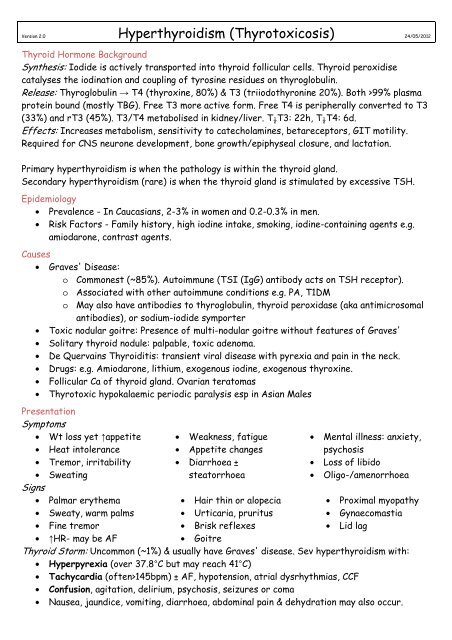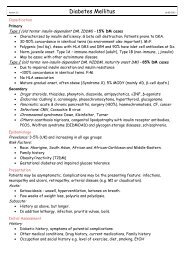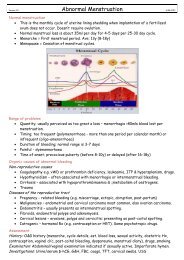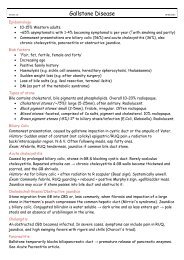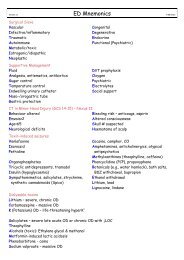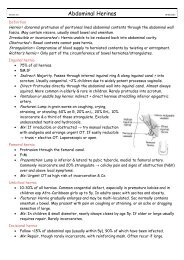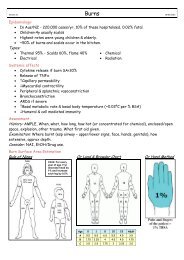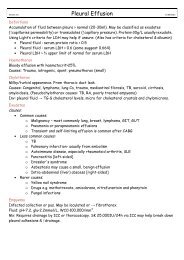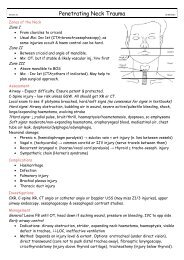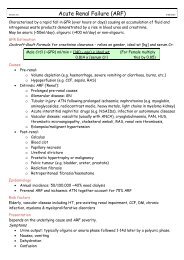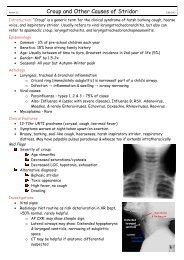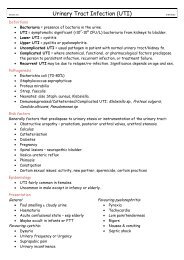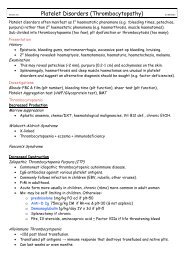Hyperthyroidism (Thyrotoxicosis)
Hyperthyroidism (Thyrotoxicosis)
Hyperthyroidism (Thyrotoxicosis)
Create successful ePaper yourself
Turn your PDF publications into a flip-book with our unique Google optimized e-Paper software.
Version 2.0 <strong>Hyperthyroidism</strong> (<strong>Thyrotoxicosis</strong>) 24/05/2012<br />
Thyroid Hormone Background<br />
Synthesis: Iodide is actively transported into thyroid follicular cells. Thyroid peroxidise<br />
catalyses the iodination and coupling of tyrosine residues on thyroglobulin.<br />
Release: Thyroglobulin → T4 (thyroxine, 80%) & T3 (triiodothyronine 20%). Both >99% plasma<br />
protein bound (mostly TBG). Free T3 more active form. Free T4 is peripherally converted to T3<br />
(33%) and rT3 (45%). T3/T4 metabolised in kidney/liver. T ½ T3: 22h, T ½ T4: 6d.<br />
Effects: Increases metabolism, sensitivity to catecholamines, betareceptors, GIT motility.<br />
Required for CNS neurone development, bone growth/epiphyseal closure, and lactation.<br />
Primary hyperthyroidism is when the pathology is within the thyroid gland.<br />
Secondary hyperthyroidism (rare) is when the thyroid gland is stimulated by excessive TSH.<br />
Epidemiology<br />
• Prevalence - In Caucasians, 2-3% in women and 0.2-0.3% in men.<br />
• Risk Factors - Family history, high iodine intake, smoking, iodine-containing agents e.g.<br />
amiodarone, contrast agents.<br />
Causes<br />
• Graves' Disease:<br />
o Commonest (~85%). Autoimmune (TSI (IgG) antibody acts on TSH receptor).<br />
o Associated with other autoimmune conditions e.g. PA, T1DM<br />
o May also have antibodies to thyroglobulin, thyroid peroxidase (aka antimicrosomal<br />
antibodies), or sodium-iodide symporter<br />
• Toxic nodular goitre: Presence of multi-nodular goitre without features of Graves'<br />
• Solitary thyroid nodule: palpable, toxic adenoma.<br />
• De Quervains Thyroiditis: transient viral disease with pyrexia and pain in the neck.<br />
• Drugs: e.g. Amiodarone, lithium, exogenous iodine, exogenous thyroxine.<br />
• Follicular Ca of thyroid gland. Ovarian teratomas<br />
• Thyrotoxic hypokalaemic periodic paralysis esp in Asian Males<br />
Presentation<br />
Symptoms<br />
• Wt loss yet ↑appetite<br />
• Heat intolerance<br />
• Tremor, irritability<br />
• Sweating<br />
Signs<br />
• Palmar erythema<br />
• Sweaty, warm palms<br />
• Fine tremor<br />
• ↑HR- may be AF<br />
• Weakness, fatigue<br />
• Appetite changes<br />
• Diarrhoea ±<br />
steatorrhoea<br />
• Hair thin or alopecia<br />
• Urticaria, pruritus<br />
• Brisk reflexes<br />
• Goitre<br />
• Mental illness: anxiety,<br />
psychosis<br />
• Loss of libido<br />
• Oligo-/amenorrhoea<br />
• Proximal myopathy<br />
• Gynaecomastia<br />
• Lid lag<br />
Thyroid Storm: Uncommon (~1%) & usually have Graves' disease. Sev hyperthyroidism with:<br />
• Hyperpyrexia (over 37.8°C but may reach 41°C)<br />
• Tachycardia (often>145bpm) ± AF, hypotension, atrial dysrhythmias, CCF<br />
• Confusion, agitation, delirium, psychosis, seizures or coma<br />
• Nausea, jaundice, vomiting, diarrhoea, abdominal pain & dehydration may also occur.
• Thyroid storm precipitants:<br />
o Infection, other acute illness<br />
o MI, PE, DKA, hypoglycaemia<br />
o Recent trauma, surgery<br />
o Withdrawal of/non-compliance with Rx<br />
o Drugs: iodine, amiodarone, contrast<br />
Extra signs in Graves' disease<br />
• Eye changes >90% - exophthalmos, ophthalmoplegia, conjunctival oedema, papilloedema<br />
and keratopathy. May be severe enough to cause visual loss.<br />
• Pretibial myxoedema 40°C<br />
Beta blockers: Propranolol 1mg/min IV up to 10mg q4h, then 20-120mg q4-6h PO (CI: asthma -<br />
but not heart failure). Can use esmolol if concerned re CCF. Diltiazem can be used if BBs CI.<br />
Antithyroid treatment: PTU or carbimazole –see below. Then give Lugol's solution after 1-4hrs.<br />
Steroids: Hydrocortisone 100mg IV q6h - blocks T4 to T3 conversion & hormone release.<br />
Treat precipitating cause.<br />
Other: DC Cardioversion for arrhythmias. NGT, sedate with chlorpromazine if sev. Agitation.<br />
Anticoagulation (heparin). If patient fails to improve within 1-2 days, consider exchange<br />
transfusion, peritoneal dialysis or haemodialysis. Involve ICU & endocrinologist.<br />
<strong>Hyperthyroidism</strong>:<br />
Antithyroid Rx: Propylthiouracil (PTU) 100-250mg q6h or carbimazole (methimazole) 10-20mg<br />
bd-tds. Inhibit the production of thyroid hormones. Onset ~1hr, full benefit may take 2-3 wks.<br />
• Propylthiouracil also decreases peripheral T4 to T3 conversion<br />
• "Dose titration" regime preferred to "block and replace" (thyroxine + antithyroid drug)<br />
• Monthly TFTs. Remission is common 18-24 months and drugs can be weaned.<br />
• SE: nausea, bitter taste, hypothyroidism, marrow suppression (FBC if sore throat)<br />
Radioiodine: 200-600 MBq PO CI: pregnancy or pregnant within 4/12, lactation<br />
• Taken up by thyroid gland leading to destruction. Preferred in toxic multi-nodular goitre<br />
• SE: may ↑Graves’ eye disease, urine excretion so avoid child contact, hypothyroid<br />
Surgical:<br />
• Sub-total or near total thyroidectomy achieves 98% cure rate. Indicated if suboptimal<br />
response to antithyroid medication or radioiodine and in children occasionally. Cx:<br />
haemorrhage, hypoparathyroidism and vocal cord paralysis.<br />
Prognosis<br />
• <strong>Hyperthyroidism</strong> is characterised by relapses and remittances.<br />
• Thyroid storm mort >90% if untreated. Early Rx reduces mort to 10-15%.


